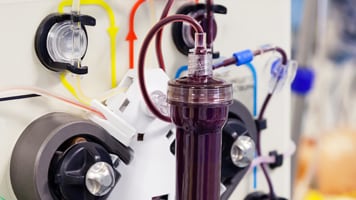Key points
- Streptococcal toxic shock syndrome (STSS) is a rare, but serious bacterial infection.
- STSS can develop very quickly into a life-threatening emergency.
- People with STSS need immediate care in a hospital and antibiotics.
- Treatment focuses on managing low blood pressure and multiple organ failure.
- Speak with a healthcare provider if you have concerns about STSS.

Symptoms
First symptoms of STSS often include:
- Fever and chills
- Muscle aches
- Nausea and vomiting
After the first symptoms start, it usually only takes about 24 to 48 hours for low blood pressure to develop. Once this happens, STSS quickly gets much more serious:
- Hypotension (low blood pressure)
- Organ failure (other signs that organs are not working)
- Tachycardia (faster than normal heart rate)
- Tachypnea (rapid breathing)
Examples of organ failure signs: Someone with kidney failure may not make urine. Someone with liver failure may bleed or bruise a lot or their skin and eyes may turn yellow.
When to seek immediate medical attention
Complications
STSS often results in complications from organs shutting down and the body going into shock. Complications can include needing surgery to remove infected tissue or limbs to control the infection.
Even with treatment, STSS can be deadly. Out of 10 people with STSS, as many as 3 people will die from the infection.
Risk factors
Anyone can get STSS, but some factors can increase the risk of getting it.
Age
STSS is most common in older adults (adults 65 years or older).
Infections or injuries that break the skin
People with an open wound are at increased risk for STSS. This can include people who recently had surgery or a viral infection that causes open sores. Varicella, like what causes chickenpox and shingles, is a virus that causes open sores.
However, experts don't know how the bacteria got into the body for nearly half of people who get STSS.
Other health factors
People with diabetes or alcohol use disorder, previously known as alcohol dependence or alcoholism, are at increased risk for STSS.
Causes
Group A Streptococcus (group A strep bacteria) cause STSS.
It is very rare for someone with STSS to spread the infection to other people. However, less severe group A strep infection can turn into STSS and these bacteria are contagious.
Prevention
There are things people can do to protect themselves and others from group A strep infections.
Testing and diagnosis
There is no single test used to diagnose STSS. Instead, healthcare providers may collect blood or other samples to test for group A strep infection. They can also order tests to see how well different organs are working.
Healthcare providers diagnose STSS when the patient has all the following:
- A group A strep infection
- Low blood pressure
- Problems with 2 or more organs
Organs that can be affected by STSS include:
- Blood
- Kidney
- Liver
- Lung
- Skin
- Soft tissue (tissue beneath the skin and muscles)
